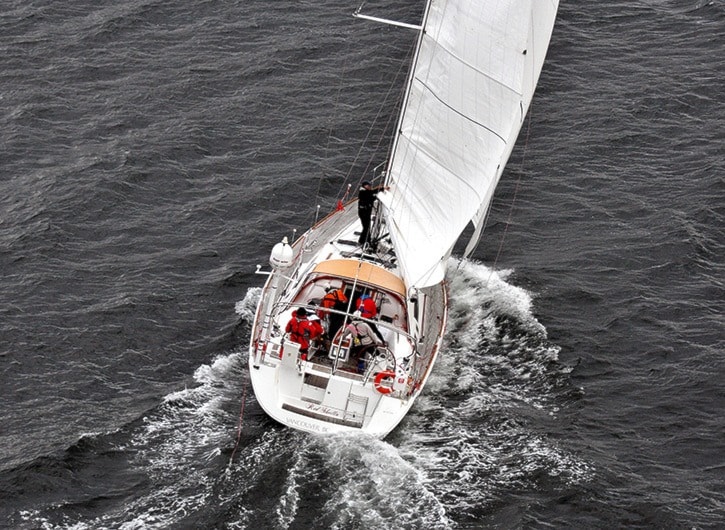For serious sailors, there’s nothing quite like the open water.
Good thing, too, because South Surrey residents Keith Martinsen and Ron Tomas are about to see an awful lot of it.
Next month, the pair – along with four other Lower Mainland sailors – will set a course from Victoria to Hawaii on Red Sheilla, a 50-foot sloop owned by another South Surrey sailor, Jim Innes, as part of the bi-annual Vic-Maui Yacht Race, a 2,300-mile journey across the Pacific Ocean.
Innes won’t be making the trip this year – though he has completed the race twice in the past – but is confident that his boat is in good hands. Martinsen, who will serve as skipper, and Tomas, one of the watch captains, both have plenty of experience on the water, and the boat itself has twice before competed in the race, in 2010 and 2012.
“It’s been there and back a couple times, so it kind of knows the way,” Innes said.
The race begins July 9 from Ogden Point near Victoria – with staggered start times between then and July 12 – and for a boat in Red Sheilla’s racer-cruiser class, typically takes 11 or 12 days to reach the Kaanapoli beaches of Maui.
And despite the marathon distance, the directions, Martinsen quipped, are fairly straightforward.
“You go out the (Strait of) Juan de Fuca, then it’s a left turn to Hawaii,” he said. “When you say it quick like that, it sounds easy.”
It’s anything but, of course.
There are myriad preparations to make – Innes, a race committee member, says they advise sailors to start preparing at least 18 months in advance – and through the years, Red Sheilla has undergone quite an overhaul in order to be worthy of such a long journey.
Upgrades include better rigging on the boat, better sails, more training for crew members, as well as additions such as a life raft.
 “Getting a boat ready can be difficult. You can’t just take it and go. You have to take an in-shore boat and turn it into an off-shore boat,” Innes explained.
“Getting a boat ready can be difficult. You can’t just take it and go. You have to take an in-shore boat and turn it into an off-shore boat,” Innes explained.
In addition, race participants have to be prepared to fix anything that goes wrong during the course of the trip, so numerous contingency plans need be in place.
“You’ve got to be ready for anything. If something breaks out there, there’s no store and nobody coming to give you a hand,” Tomas said.
Innes – who, years ago, completed just “one-64th of the race” after his boat’s mast broke just off the start line – agreed with his fellow sailor’s take, adding that often the only help available is from fellow racers, if they happen to be in the same vicinity.
“West Marine is a long way away. You’re 1,500 miles from anywhere… the closest land is 25,000 feet below you, and you don’t want anything to do with that,” he said.
The race is staged in July because “it’s when the Pacific Ocean is at its most benign,” Innes said, though racers still need to prepare for all potential obstacles.
“It is still the big ocean and anything can happen,” he said.
And though the race poses an impressive challenge for even the most seasoned captain, it’s also enjoyable and the allure of the open water is strong, Martinsen is quick to point out.
“I remember the first time I did the race, and you kind of forget how big the ocean really is,” he said. “You get out past Juan de Fuca and you lose sight of land then you’re out there for 10 or 11 days before you see land again.
“It’s isolating, but it’s also beautiful. The waves are absolutely spectacular, and unless you’ve been out that far into the ocean, you’ve never seen water so blue in your life. It turns a deeper and deeper blue, and it’s absolutely gorgeous.”
By the third day of the trip, “it’s like looking at the sky,” Innes added.
While Martinsen – who has been sailing since 1956 when he was “13 or 14 years old” – has twice done the Vic-Maui race, it’ll be a first for Tomas, who is accustomed to shorter races in his own catamaran, which is built more for speed than long distances.
“I’m really excited,” said Tomas, whose racing resume includes racing around Vancouver Island, as well as a few events in California. “I’m accustomed to making the boat go as fast as possible.”
Though he will be keeping both feet on dry land this time around, Innes has a personal connection to the Vic-Maui race – it was co-founded by his father in 1965.
“My father started it with four other sailors who he’d convinced to go. In those days, there was really no other race like it. The only other race from the west coast of North America to Hawaii was one out of L.A. – the Trans-Pac, which is still going, in alternate years from (Vic-Maui).”
With the race just two weeks away, the majority of the prep work is already completed, aside from stocking the sloop with supplies and food – though no bananas, as per the longtime sailing superstition that dates back to the 1700s. (They’re thought to bring aboard bad luck.)
Tactical plans have been mapped out, radio frequencies tested and tested again, and all that’s left now is to climb aboard and hope for strong winds and sunny skies.
“You just try to make the boat go as fast as it can, without breaking anything or hurting anybody,” Martinsen said.
